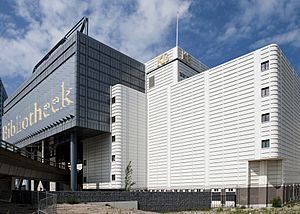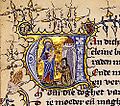Royal Library of the Netherlands facts for kids
Quick facts for kids Royal Library of the Netherlands |
|
|---|---|
 |
|
 |
|
| The KB as seen from the Prins Bernhardviaduct | |
| Type | National Library |
| Established | 1798 |
| Location | The Hague |
| Coordinates | 52°4′50.37″N 4°19′36.35″E / 52.0806583°N 4.3267639°E |
| Collection | |
| Size | 7 million printed items: over 115 km (71 mi) of books, newspapers, journals, and microforms |
| Access and use | |
| Members | 16,975 |
| Other information | |
| Budget | €128 million (2023) |
| Director | Wilma van Wezenbeek |
| Staff | 481 FTE (2023) |
The KB National Library of the Netherlands is the main library for the whole country. It is also known as the Koninklijke Bibliotheek (which means Royal Library) or simply KB. It is located in The Hague, a city in the Netherlands. This important library was started way back in 1798.
The KB collects almost everything published in or about the Netherlands. This includes old medieval literature and new books from today. Imagine 7 million items stored there! These include books, newspapers, magazines, and maps. The KB also has cool digital services. You can find e-books and audiobooks online. There's also Delpher, which has millions of old digitized pages. And "The Memory" website has about 800,000 images. Since 2015, the KB has helped guide all the public libraries in the Netherlands. The KB's collection of websites from an old internet provider, XS4ALL, is so special it's on the UNESCO World Heritage list. It was the first web collection in the world to get this honor!
Contents
A Look at History
How the Library Started
The idea for a national library came from a person named Albert Jan Verbeek. He suggested it on August 17, 1798. The library's first collection came from books that belonged to William V, Prince of Orange. These books were taken for the new library. The library officially opened on November 8, 1798. It was first called the Nationale Bibliotheek, meaning National Library. At first, only members of the government could use it.
Becoming the Royal Library
In 1806, King Louis Bonaparte gave the library the special title 'Royal'. Later, in 1815, King William I of the Netherlands officially confirmed the name 'Royal Library' (Koninklijke Bibliotheek). This was done through a royal order. In 1982, when the library moved to a new building, it became known as the National Library of the Netherlands.
Since 1996, the KB has been an 'Independent Administrative Body' of the state. This means it runs itself, but the government still helps pay for it. In 2015, a new law brought four different library organizations together under the name Koninklijke Bibliotheek. These included groups for public libraries and digital books. In 2020, the name was updated to 'KB, national library'.
What the KB Does
The main job of the KB is to get, organize, store, and share all the printed and digital books from the Netherlands. This way, everyone in the country can read, learn, and do research. The KB also helps guide and coordinate all the public libraries. Together with these libraries, the KB is building a big national digital library for everyone to use.
Amazing Collections
What's Inside the KB
The KB's older collections focused on subjects like Dutch history, language, and culture. But since 1974, they also collect books on science and social sciences. This is part of their 'Depot van Nederlandse Publicaties' (Depository of Dutch Publications) program.
In 2016, the KB had 7 million items. If you lined them all up, they would stretch for 115 kilometers! Most of these items are books. The collection has almost all the literature from the Netherlands. This ranges from very old medieval handwritten books to new scientific papers. Unlike many other countries, the Netherlands doesn't have a law that forces publishers to send copies of their books to the library. So, the KB started a voluntary program in 1974. Publishers can choose to send their books to the 'Dutch Repository Library'. For a book to be accepted, it must come from a registered Dutch publisher.
Special Treasures
The Royal Library of the Netherlands also has amazing art and very old items. One beautiful piece of art is The Madonna with the Christ Child. This painting is from the 1400s by a French painter named Jean Fouquet. He was one of the best painters of his time.
Another valuable old item is a book from the 1500s by Christopher Plantin. He was a famous French printer. The book has a special brown leather cover with gold designs. It was made in Plantin's workshop in Antwerp. The library also has unique paper from the 1700s from Germany.
There's also a rare book from 1596 with many pictures. It tells about the travels of Jan Huygen van Linschoten. He traveled to places like Spain, India, and Indonesia.
One of the oldest pictures of 'Dutchmen' is also at the library. It's in a medieval book called the Egmond Gospels. This book was given to a monastery in 975. It's one of the oldest church treasures still around. It shows pictures of Dutch people and buildings. The Egmond Gospels were lost for a while but found again in the 1800s. The Dutch government bought it to keep it safe at the Royal Library.
The library also has the Trivulzio Book of Hours from around 1465. This is a tiny medieval book, only 9 cm by 13 cm. It has amazing, detailed Flemish miniature art. One of the most precious atlases is the Atlas van der Hagen. It has four volumes, each with over 100 maps and prints. These were made around 1690. All the pictures were colored by hand and highlighted with gold!
In 1871, the library bought a large collection of books about chess. Combined with another collection bought in 1948, the Biblioteca van der Linde-Niemeijeriana has about 40,000 items. It's one of the most important chess collections in the world!
You can use the collection if you are a member. Anyone aged 16 or older can become a member. You can also get a one-day pass. It takes about 30 minutes to get materials you request. The KB also has several free-to-use websites. These include "Memory of the Netherlands" and Delpher, which had over 100 million pages by 2020. The KB also has items related to the Fagel Collection.
Dutch Publications Deposit
The KB started a voluntary program for Dutch publications on January 1, 1974. Since 1985, government groups and institutions that get money from the government have to send a free copy of their publications to the KB. The KB tries to collect as many Dutch books, magazines, and maps as possible. This includes items published in the Netherlands, or written by Dutch people abroad, or about the Netherlands. Music sheets and Braille books are not included. Local newspapers were collected at first, but this stopped in 1992. The information about these publications is put into the Dutch National Bibliography. This helps manage a part of the Dutch cultural heritage. To protect the rights of the authors, most publications can only be looked at inside the library. They can only be viewed online if the author agrees.
Short-Title Catalogue, Netherlands (STCN)
The Short-title catalogue, Netherlands (STCN) is a service from the KB. It's a database of old Dutch books published up to the year 1800. This includes books printed in what is now the Netherlands. It also covers books published in the Dutch language outside the Netherlands. The STCN uses collections from libraries both inside and outside the Netherlands. By November 2013, the database had over 200,000 titles. The STCN project finished in 2009, but the KB keeps adding to the database every day.
Literature Museum
The Literature Museum was founded in 1750. It has a huge collection of letters, handwritten papers, and special items. The museum has three permanent exhibits and often hosts temporary ones. It also has a special children's book museum! In 2016, an online museum was launched. The museum has a reading room where you can look at old newspaper clippings. You can also see some old archive materials under certain rules.
Special Exhibitions
For the library's 200th birthday in 1998, they held an exhibition called Het worderbaarlijke alfabet (The Miraculous Alphabet). It was at the Nieuwe Kerk, Amsterdam. They also released three books and a special stamp.
In 2002, a big exhibition called Wonderland, from Pietje Bell to Harry Potter was held. This one was especially for children! It took place at the Kunsthal in Rotterdam. They showed a selection from their collection of 125,000 children's books. Many school children, aged 8 to 12, came from all over the Netherlands. This was a huge success!
In 2006, when a new storage area was opened, the exhibition Magazine! was organized. It was set up like a giant 3D magazine that visitors could walk through.
Research at the KB
The KB has a Research Department that does important work. They research digital technology and how to keep old paper and digital items safe. They also look at how to make these items easy to find and use. Some key topics they study include how to use artificial intelligence and big data. They also look at how publishing is changing. And they study the role of public libraries in today's world.
Art with a Past
In 2015, it was found that a painting called “View of the Kattenberghof in Antwerp with horsemen in the foreground” by Gillis Neyts had belonged to Dr. Arthur Feldmann. He was a Jewish art collector who died during the Holocaust. In 2020, it was discovered that a watercolor from 1876 by Félicien Rops had belonged to a French collector named Armand Dorville. These items were taken unfairly during a difficult time in history.
The KB Building
Since 1982, the library has been in a modern building in The Hague. It's right next to The Hague Central Station. The building is very large, with about 78,000 square meters of space. It stands out with its 5,200 white aluminum plates on the outside. The building is next to the Nationaal Archief (National Archives).
Many other important organizations are also in the KB building. These include the 'Literatuurmuseum' (Literary Museum), the Kinderboekenmuseum (Children's Book Museum), and the RKD. Before this building, the library was in an old city palace called Huis Huguetan from 1821 to 1982. Before that, it was in the Mauritshuis from 1807 to 1821, and even earlier, at the Binnenhof from 1798 to 1807.
Images for kids
-
Microfiche and microfilm room KB, 2013
See also
 In Spanish: Biblioteca Real Neerlandesa para niños
In Spanish: Biblioteca Real Neerlandesa para niños
- Books in the Netherlands
- European Library
- List of libraries in the Netherlands
- Nederlandse Centrale Catalogus (Dutch Central Catalog)

















